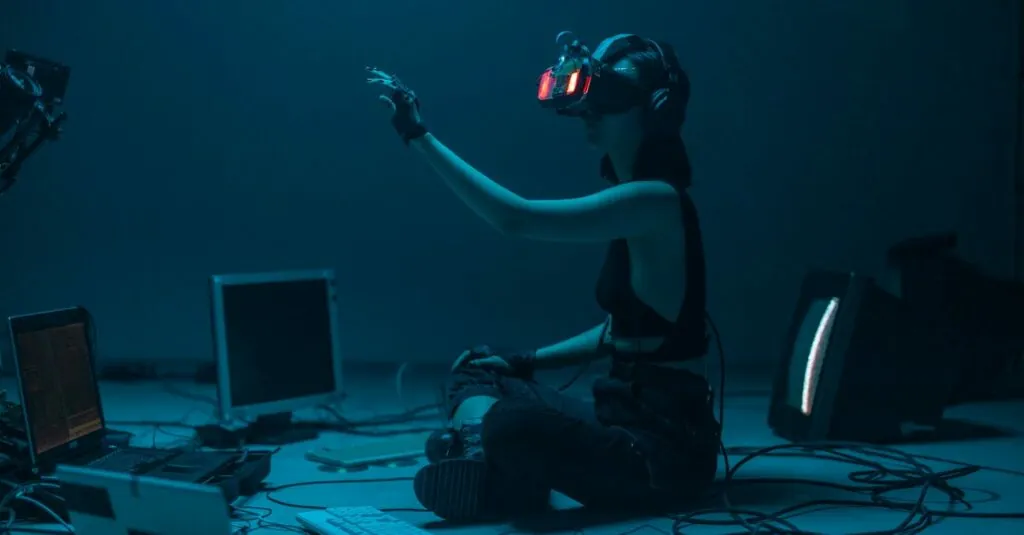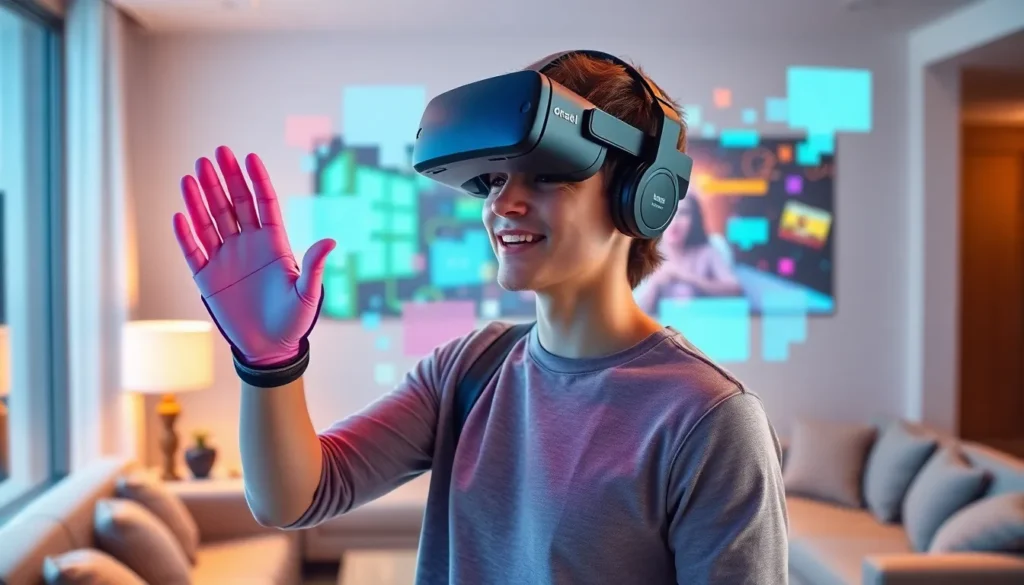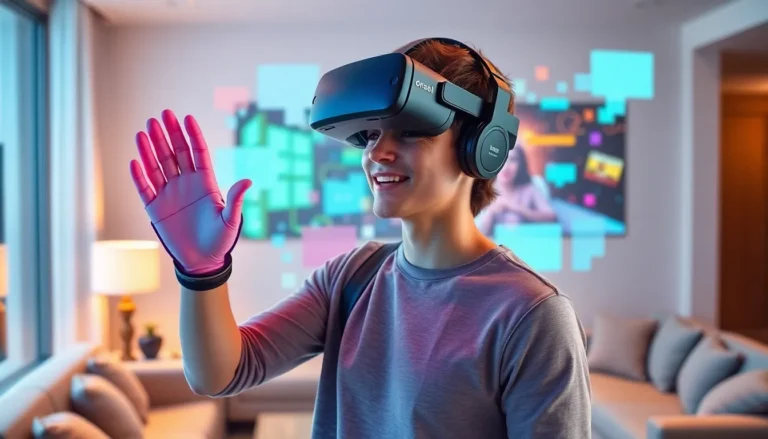Table of Contents
ToggleVirtual reality technology is no longer just a sci-fi dream; it’s a thrilling reality that’s reshaping how we experience the world. Imagine slipping on a headset and instantly being transported to a bustling city or a serene mountaintop, all while sitting on your couch in your pajamas. The latest advancements in VR are making these experiences more immersive and accessible than ever before.
From gaming to education and even therapy, VR is revolutionizing industries and redefining entertainment. It’s not just about playing games anymore; it’s about engaging with content in ways that were once thought impossible. So buckle up and get ready to dive into the exciting realm of the latest VR technology—where the only limit is your imagination (and maybe your living room space).
Overview Of Latest VR Technology
Latest advancements in virtual reality technology revolutionize user experiences across various sectors. Companies continuously innovate to enhance immersive environments. New VR headsets feature higher resolution displays and improved tracking systems, boosting realism in gaming and simulations.
Artificial intelligence integration improves VR experiences. It personalizes content and enhances user interaction, making environments feel more dynamic. Hand-tracking technology expands user engagement, allowing for natural movement and manipulation within virtual spaces.
Software developments support a broader range of applications. In education, VR fosters interactive learning experiences, enabling students to explore complex concepts hands-on. Therapy sessions incorporate VR to treat phobias and anxiety, providing patients an accessible pathway to confront fears.
Hardware progress focuses on reducing motion sickness, an ongoing challenge for users. Advanced algorithms adjust frame rates and rendering, providing smoother experiences. Wireless capabilities also enhance mobility, enabling users to explore virtual worlds without hindrance.
Collaboration tools within VR promote teamwork in virtual settings. Remote teams use shared VR spaces for meetings, increasing engagement and interaction. Businesses leverage these technologies to create training modules that simulate real-life scenarios, improving workforce skills.
Investment in VR technology continues to rise, reflecting its growing importance in the market. Analysts project consistent growth, estimating the global VR market to reach $57 billion by 2027. This expansion confirms a bright future for VR, indicating an increasing integration into everyday life.
Current Trends In VR Technology
Recent advancements in VR technology showcase innovative solutions shaping user experiences. Continued emphasis on enhancing realism, usability, and accessibility drives the industry forward.
Innovative Hardware Developments
Manufacturers introduce cutting-edge VR headsets featuring higher resolution displays, improved tracking systems, and lighter designs. Enhanced hardware reduces motion sickness, allowing users to enjoy longer sessions comfortably. Wireless capabilities expand mobility, giving users greater freedom to explore virtual environments. Controllers utilize improved haptics, delivering responsive feedback that increases immersion. The integration of eye-tracking technology elevates user interaction within virtual spaces, creating realistic navigation experiences.
Software Advancements
Developers focus on leveraging artificial intelligence to personalize VR content for individual preferences. Enhanced software broadens VR applications across education, therapy, and entertainment. Interactive learning platforms offer immersive educational experiences, while therapeutic applications help users confront phobias effectively. Collaboration tools in VR foster teamwork by enabling users to engage in shared virtual workspaces. Continuous updates enhance user interfaces, ensuring smoother experiences across different platforms. As software evolves, it supports expanding user engagement and interaction.
Key Players In The VR Industry
The virtual reality industry features key players driving its growth and innovation. Major companies lead in developing hardware and software solutions that enhance user experiences.
Major Companies
Meta, formerly Facebook, dominates the VR market with its Quest series, which emphasizes accessibility and community engagement. Sony has made significant strides with its PlayStation VR, catering to gamers looking for immersive experiences. Moreover, HTC Vive focuses on premium hardware designed for professional and enterprise use. Valve’s Index headset offers high-performance visuals and innovative controllers, maintaining a strong presence in the gaming sector. Together, these companies cover a wide range of consumer needs, shaping the future of VR technology.
Emerging Startups
Emerging startups contribute fresh perspectives and innovative solutions to the VR landscape. Companies like Varjo are pushing the envelope with ultra-high-resolution headsets aimed at professionals in design and training fields. Another promising player, Bigscreen, has revolutionized social VR by allowing users to watch movies together in virtual environments. Additionally, Spatial focuses on creating a virtual workspace that fosters collaboration among remote teams. These startups complement established firms, driving diversity and creativity in VR applications.
Applications Of Latest VR Technology
Virtual reality technology is finding diverse applications across various sectors.
Entertainment and Gaming
VR transforms entertainment experiences, providing immersive gaming environments. Users explore vast virtual worlds, engaging in multi-player scenarios that mimic real-life interactions. Game developers enhance graphics and physics, offering realistic gameplay. Innovations like haptic feedback add tactile sensations, allowing players to feel actions in real-time. VR arcades also gain popularity, offering dynamic experiences that draw crowds seeking adventure outside the home.
Education and Training
Educational applications of VR enable interactive learning experiences. Students dive into simulated environments, exploring historical events or scientific concepts firsthand. Virtual classrooms facilitate global connections, allowing collaboration among peers regardless of location. Training programs utilize VR for skill development, particularly in fields like aviation and medicine. Participants practice complex procedures through realistic simulations, honing their skills in a risk-free setting.
Healthcare and Therapy
VR plays a significant role in healthcare, offering new therapies for various conditions. Patients access immersive environments that aid in treating phobias and anxiety disorders. Virtual reality exposure therapy allows gradual exposure to fears in controlled settings, promoting desensitization. Medical professionals also utilize VR for surgical training, simulating operations for skill enhancement. Rehabilitation programs incorporate VR to motivate patients, making therapy sessions more engaging and effective.
Challenges Facing VR Technology
Virtual reality technology faces several challenges that impact its growth and adoption. These challenges include technical limitations and user adoption issues that collectively hinder widespread acceptance.
Technical Limitations
Technical limitations in VR technology include hardware constraints, which can restrict performance and user experience. Current headsets often have limited battery life, affecting long-term usage. Resolution and refresh rates may not match users’ expectations, leading to visual discomfort. Latency can result in motion sickness, particularly for sensitive users. In addition, the requirement for powerful computing hardware adds complexity and cost for end users. Developers must address these issues to create seamless, engaging experiences that retain users longer.
User Adoption Issues
User adoption issues arise from various factors that deter potential VR users. High costs associated with purchasing headsets and compatible hardware present a significant barrier. Many users also cite concerns about motion sickness as a deterrent to trying VR experiences. Limited content availability can make it hard for users to see the value in investing in VR. Additionally, unfamiliarity with the technology creates apprehension among prospective users. Marketing and education about VR’s benefits can help increase interest and participation in this evolving technology.
The rapid evolution of VR technology is reshaping how individuals experience entertainment education and healthcare. With advancements in hardware and software users can expect increasingly immersive environments that enhance interaction and engagement. The ongoing investment in this sector indicates a promising future where VR becomes an integral part of daily life.
As major companies and innovative startups continue to push boundaries the potential applications of VR will only expand. Addressing current challenges and improving user accessibility will be key to unlocking VR’s full potential. Embracing these advancements allows users to explore new realities and redefine their understanding of the world around them.







